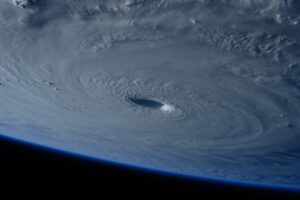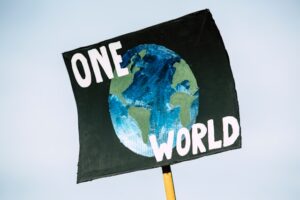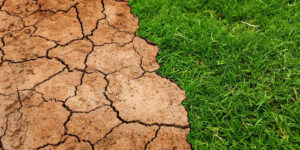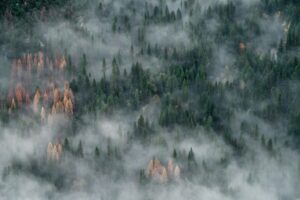Climate change and global warming have been knocking our doors for a long time. We see on a daily basis news about natural disasters that are consequences of these phenomena in the news and the internet. However, its causes aren’t always mentioned nor detailed. According to a study made in 2013 where 11.944 scientific papers were reviewed, 97.2% of the scientists that take a position regarding climate change agree that it is generated due to human actions.
In this article, the 10 causes of climate change and global warming will be listed and described.
1. Fossil-fuels based economies
The accumulation of CO2 in atmosphere is the reason why the earth is getting warmer and warmer. Although this CO2 is a natural part of the carbon cycle, fossil-fuels burning alters its equilibrium causing the accumulation of too much CO2 in the atmosphere that the earth can’t capture. Therefore, the fossil fuels burning accounts for one of the main causes of climate change and global warming.
Most developed countries have grown their economies through fossil fuels burning like coal, oil and gas in order to provide electricity and energy to industries. Recently, because of environmental regulations, some countries have started to switch their economies to greener energies. However, developing countries that are now becoming industrialized are also growing their economies through fossil fuels.
According to EPA, 55% of 2018 greenhouse gases (GHG) emissions can be attributed to transport and electricity. In spite of the environmental regulations implemented in developed countries, energy produced worldwide still uses fossil fuels are its main input (Image 1). (10 causes of climate change and global warming)
Image 1: Energy consumption by source. Source: Our world in data
2. Transport
The transport sector accounts for 21% of the total CO2 emissions. This includes flights, road transport and shipping (Image 2). Although EV vehicles are starting to emerge in developed countries, still most passenger cars use fossil fuels as a main source for energy.
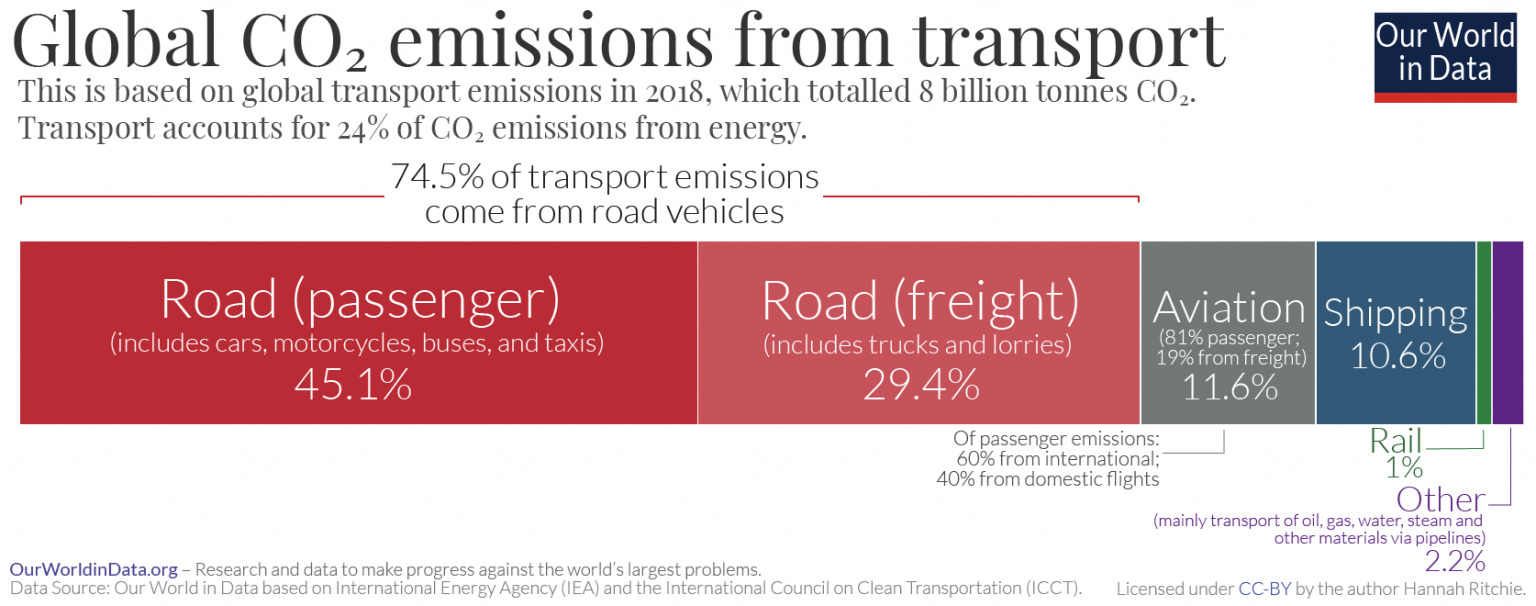
Image 2: CO2 emissions from transport
Source: Our world in data
3. Forest fires
The National Park Service of the US accounts that according to data based on Wildland Fire Management Information (WFMI), 85% of forest or wildland fires in the US are caused by humans. Some of these causes may be unattended campfires, malfunctions of equipment, cigarettes discarded and intentional acts of arson.
When a fire occurs, large amounts of CO2 are released because of the combustion that takes place. If this CO2 is not absorbed again by other plants or trees through photosynthesis, it remains accumulated in the atmosphere. In addition to this, after the fires are over, the trees continue to emit CO2 into the atmosphere. According to a report by the Forest Carbon and Emissions model, the amount of CO2 released in the post-fire process is 3 times greater than that released during combustion, due to the large amount of wood and plant materials that remain unburned after a wildfire.
On the other hand, the soil is also responsible for storing carbon that would otherwise be released into the atmosphere in the form of CO2. During fires, not only a large amount of water stored in the soils is evaporated due to high temperatures but also gases like CO2 are released due to the combustion of organic matter. The high temperatures are also responsible for accelerating the soil respiration, which can contribute to an increase of the climate change effects of forest fires.
4. Meat & animal products consumption
Industrial animal farming is another one of the major causes of climate change. Population growth and animal products demand have forced to a food system that is not sustainable. According to the FAO, livestock farming is responsible for 14.5% of greenhouse emissions. This positions this activity as the third largest contributor after the burning of fossil fuels.
During animal farming not only CO2 is released due to the deforestation process, but also other greenhouse gases with a higher global warming potential (GWP). Nitrous oxide (N2O), which gas a GWP 298 times higher than CO2, is released due to the nitrogen based fertilizers use. Also, due to the characteristic metabolism of ruminants, large quantities of methane (CH4) are released from the animals during all of their lives.
Livestock is responsible for about 75% of the N2O emissions, 35% of all CH4 emissions and 80% of all CH4 agriculture emissions.
5. Changes in land use (deforestation)
Photosynthesis is one of the main processes in the carbon cycle. This takes place when plants and trees capture CO2, and convert it into organic matter. Therefore, when deforestation takes place to change the land use, they remove the main source of CO2 absorption. This leads to an excess of CO2 in earth that cannot be captured and in consequence accumulates in the atmosphere, causing the global warming that we are currently experiencing.
6. Urbanization (10 causes of climate change)
Although urban areas only cover the 3% of the Earth’s surface, more than 50% of the world’s population is today located in these highly-dense cities. And this % is expected to increase to 68% by 2050, according to the UN. Unlike rural centers, big cities require more energy and resources both for its construction and operation.
The fact that more people are moving to urban centers transforms the way the world live, work and travels. In addition to this, the construction industry and buildings are responsible for 39% of all CO2 emissions worldwide. 28% of these emissions come from operational services like heating, cooling and lighting.
7. Waste generation (10 causes of climate change)
When disposed in a landfill, the anaerobic digestion that takes place to treat waste streams generate methane, which is one of the GHG that contributes to global warming.
Waste generation emissions account for 3% of total greenhouse gases generated worldwide. This percentage decreased significantly in the last 2 decades with recycling, composting and methane recovery systems worldwide. However, in many countries waste disposition still takes place in open dumps or landfills without methane capture systems.
8. Overpopulation and climate change (10 causes of climate change)
Humans are the driving cause of climate change. We are the ones consuming energy, food and goods. Therefore, the population growth is a key factor in CO2 emissions, especially in most developed countries with higher consumption habits. Only in the last 100 years, human population grew from 1.6 billon to 6.1 billon people. And although in many countries population growth is slowing down, we won’t see a population peek until 40 years from now.
9. Over-consumption (10 causes of climate change)
In addition to overpopulation, the changes in people’s consumption habits is also leading the climate change crisis. The consumers are the ultimate drivers of production, because it is their purchasing decisions that lead the production activities and industries. According to an OXFAM report, the richest 10% of the world’s population were responsible for 52% of the cumulative carbon emissions between 1990 & 2015. This is mainly due to their higher consumption levels, travel frequency and lifestyles.
10. Single use packaging & plastics (10 causes of climate change)
Single use plastics and packaging contribute to global CO2 and CH4 emissions in every stage of their life cycle. Starting from its raw materials extraction (oil, gas, chemicals) to their manufacturing, their transport and final disposal in landfills. According to EPA, plastics account for 17.3% of all waste disposed in landfills, and 50% of the plastics we buy are discarded after only 1 use.
-Belén Silva
References:
EPA, Greenhouse gases emissions
Our world in data, Energy sources
NPS, Percentage of forest fires caused by humans
Sejian, Veerasamy & Bhatta, Raghavendra & Malik, Kumar & Madiajagan, Bagath & Ali, Yaqoub & Al-Hosni, Yaqoub & Sullivan, Megan & Gaughan, J.. (2016). Livestock as Sources of Greenhouse Gases and Its Significance to Climate Change. 10.5772/62135.
Bazrkar, M. H., Zamani, N., Eslamian, S., Eslamian, A., & Dehghan, Z. (2015). Urbanization and Climate Change. Handbook of Climate Change Adaptation, 619–655. doi:10.1007/978-3-642-38670-1_90
OXFAM report, Confronting carbon inequality, 2020.
Image by Anja🤗#helpinghands #solidarity#stays healthy🙏 from Pixabay


